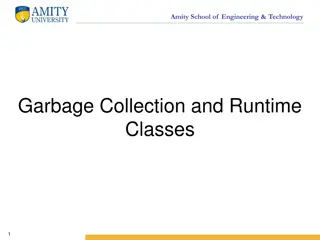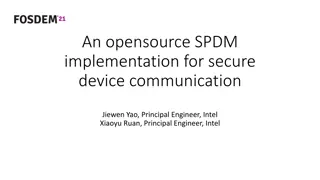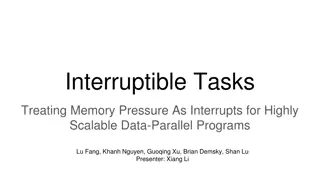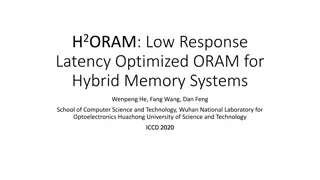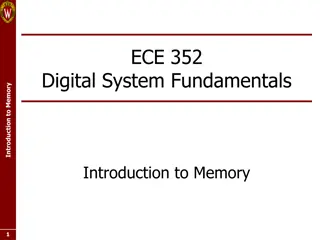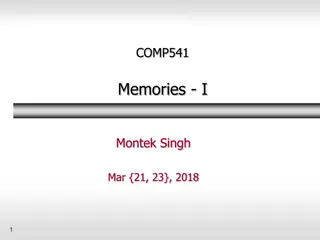
Device Memory Interaction
Explore the intricate details of how devices interact with memory in operating systems. Learn about kernel address space, devices with onboard memory, DMA, and address types like physical, virtual, and bus addresses. Delve into high and low memory configurations in 32-bit architectures and the evolution with 64-bit systems.
Uploaded on | 1 Views
Download Presentation

Please find below an Image/Link to download the presentation.
The content on the website is provided AS IS for your information and personal use only. It may not be sold, licensed, or shared on other websites without obtaining consent from the author. If you encounter any issues during the download, it is possible that the publisher has removed the file from their server.
You are allowed to download the files provided on this website for personal or commercial use, subject to the condition that they are used lawfully. All files are the property of their respective owners.
The content on the website is provided AS IS for your information and personal use only. It may not be sold, licensed, or shared on other websites without obtaining consent from the author.
E N D
Presentation Transcript
Device Memory Interaction Marion Sudvarg, Chris Gill, David Ferry, Brian Kocoloski CSE 522S Advanced Operating Systems Washington University in St. Louis St. Louis, MO 63130 1
Review: Device I/O Device I/O registers are accessed as memory addresses (On x86, some I/O registers use a separate address space and different CPU instruction, but conceptually similar to memory) These addresses are mapped into the kernel virtual address space using ioremap CSE 522S Advanced Operating Systems 2
Today: Device Memory Interaction More detailed discussion of how devices interact with memory, covering: The kernel address space in more depth Devices with onboard memory (e.g. graphics cards) Direct Memory Access (DMA) by devices to main memory CSE 522S Advanced Operating Systems 3
Address Types Physical Addresses The addresses used by the CPU to access physical memory (RAM and IO registers) User Virtual Addresses Give userspace processes the illusion of full access to complete, contiguous system memory Kernel Virtual Addresses Allow a similar mapping of virtual to physical in the kernel Provides a way to split Source: Linux Device Drivers (3rd Edition) Bus Addresses The addresses used between peripheral buses and memory The physical address used by the CPU to access a device might be converted to a bus address by the host bridge CSE 522S Advanced Operating Systems 4
High and Low Memory 32-bit architectures limited to 4GB of virtual memory Splits memory between kernel space and user space, allowing kernel and user space to share an address space The kernel maps 1GB of contiguous memory into its virtual address space The corresponding virtualaddresses are called kernel logical addresses The corresponding physicaladdresses are called low memory Memory outside of this range (reserved for userspace) is called high memory 32-bit address extensions, and 64-bit address spaces, have largely made this split obsolete on x86 Nonetheless, the kernel still maps contiguous logical addresses at boot CSE 522S Advanced Operating Systems 5
Recall: Virtual Memory Areas Pages are mapped to virtual memory Virtual addresses require translation A VMA is the kernel data structure that manages a regionof a process s address space Virtual Address Translation: Process A Process B Virtual Address Page# Offset 4KB 4KB 4KB 4KB 4KB 4KB Physical Page Phys. Addr CSE 422S Operating Systems Organization 6
Memory Maps Recall that a process address space has several memory maps Each map is backed by a VMA in the kernel CSE 522S Advanced Operating Systems 7
Memory Mapped Devices Recall that device registers can often be addressed as physical memory This physical memory may be mapped as kernel virtual addresses What about a device that has its own memory? The memory can be mapped as pages in the kernel address space! CSE 522S Advanced Operating Systems 8
Example: Graphics A graphics card has a frame buffer Memory region defining the current display output This is accessed over the bus as a physical address region The graphics driver maps this into the kernel address space Can be provided directly to userspace (e.g. X Window server) Frame Buffer Control Registers PCIe Bus Address PCIe Bus CPU CSE 522S Advanced Operating Systems 9
Object-Oriented VMA Operations VMA is backed by a vm_area_struct This backs a memory-mapped region Contains a pointer to a vm_operations_struct Recall the object-oriented operations provided by VFS! For example, the file object has a file_operations table that allows different filesystems to define behavior for corresponding syscalls (open, read, write, etc.) Similarly, a VMA allows a driver to define what happens when it is opened, closed, and when a page not in memory is accessed This is especially useful for when a process with a VMA forks (the VMA is copied) or exits (the VMA is destroyed) Think of open as a constructor (and copy constructor) and close as a destructor CSE 522S Advanced Operating Systems 10
Direct I/O Recall: block I/O can be very slow! The page cache allows I/O requests to be served from RAM On cache miss or writeback, I/O scheduling performs: Request merging Request sorting Read-vs-write priority Alternatively, a driver can provide direct I/O access to userspace via mapped VMAs! CSE 522S Advanced Operating Systems 11
Direct Memory Access CPU RAM DMA allows devices to access main memory directly, bypassing the CPU Northbridge Southbridge DMA CSE 522S Advanced Operating Systems 12
IOMMU Connects DMA-capable I/O bus to main memory Translates device-visible virtual addresses to physical addresses Provides memory protection from faulty/malicious devices Source: https://en.wikipedia.org/wiki/Input-output_memory_management_unit CSE 522S Advanced Operating Systems 13
Synchronous DMA Process Driver provides a read() function for the device in the VFS operations table syscall(__NR_read) Userspace 1. Process makes a read() syscall (blocking) Driver function allocates a DMA buffer Maps buffer into process Driver provides hardware with buffer address Hardware writes data to buffer Hardware raises interrupt Interrupt handler runs and awakens the process Kernel DMA buffer 2. Driver int. handler Syscall Handler Driver read() 3. 4. 5. 6. 7. Device dostuff(&buffer) CSE 522S Advanced Operating Systems 14
Asynchronous DMA Some hardware should always push data e.g. network cards A listening socket should continue to get data even while the server process is not blocked on read() 1. Device has data ready 2. Device raises interrupt 3. Driver interrupt handler allocates buffer (or increments ring buffer pointer) 4. Int. handler tells hardware where to transfer data 5. Hardware writes data 6. If processes are blocked on read(), driver will wake them as necessary Process Userspace DMA buffer Driver int. handler Kernel dostuff(&buffer) Device recvd packet CSE 522S Advanced Operating Systems 15
DMA Buffer Allocation Can use kmalloc or get_free_pages What if these fail? Kernel module cannot preallocate memory at boot time! Use kernel boot argument: Say you have 1024MB of RAM and want to reserve 64MB for DMA buffers Use mem=960M kernel boot argument To allocate buffers, ioremap the memory past 960M What if you want less than a page of memory? Use a DMA pool! Similar in concept to malloc() allocating from heap (instead of using mmap() for larger allocations) CSE 522S Advanced Operating Systems 16
Bus Addresses Bus addresses are tricky! CPU addresses memory according to front-side bus addressing Devices address memory according to their bus connection may use a different address May also be complicated by presence of IOMMU Kernel provides virt_to_bus and bus_to_virt macro functions to portably convert physical/logical addresses to bus addresses These are wrapper fa ades provided by highly platform-specific headers CSE 522S Advanced Operating Systems 17
Other Considerations Remember to use compiler and hardware memory barriers! Ensure cache coherency is properly managed (kernel provides wrapper functions) Some architectures support scatter/gather DMA buffers If you re interested in more depth, read all of LDD chapter 15! CSE 522S Advanced Operating Systems 18
Todays Reading Review LKD pages 231-245 Selections from LDD Chapter 15, Memory Mapping and DMA : Pages 412-424: Stop before Using remap_pfn_range Pages 440-448: Begin at Direct Memory Access, stop before Setting up streaming DMA mappings CSE 522S Advanced Operating Systems 19







